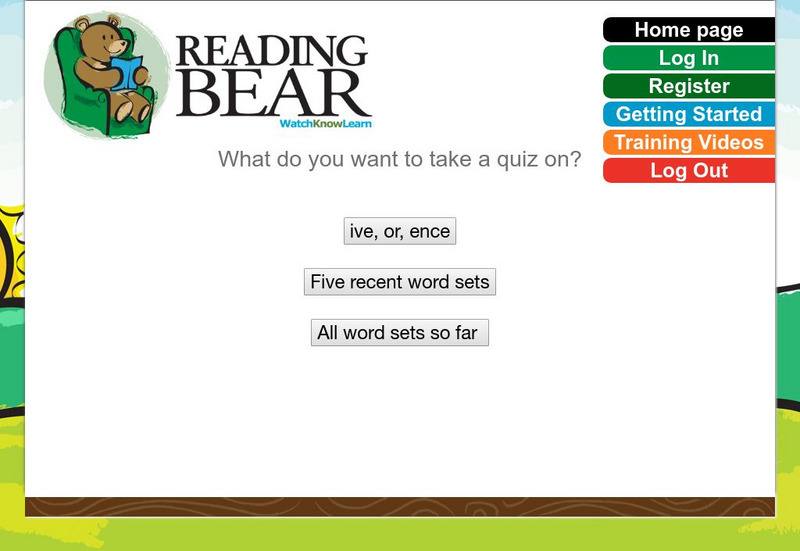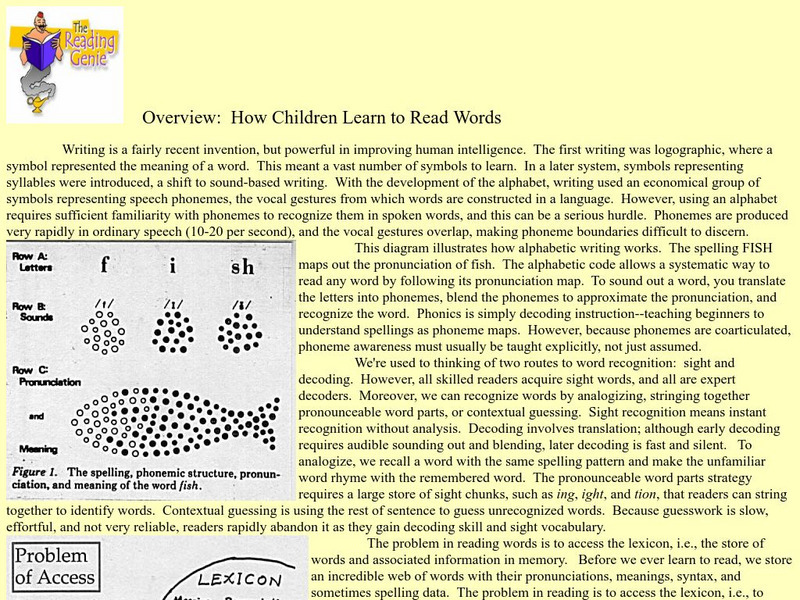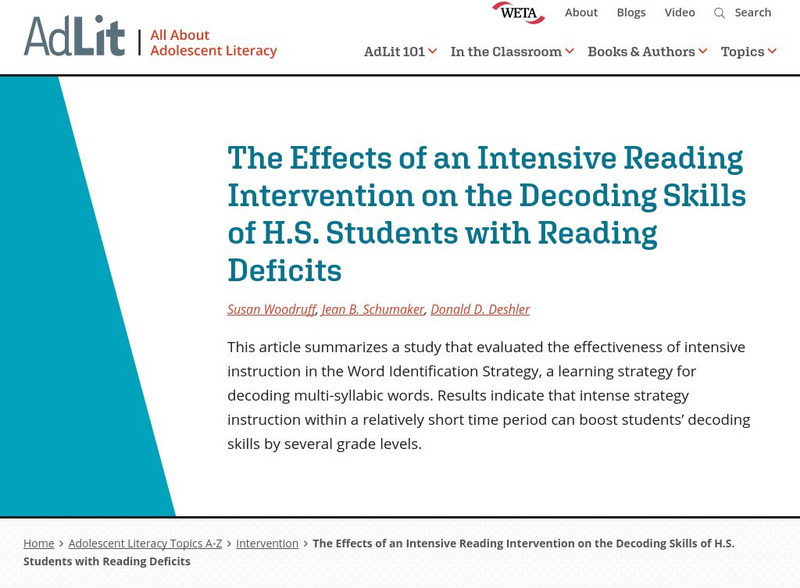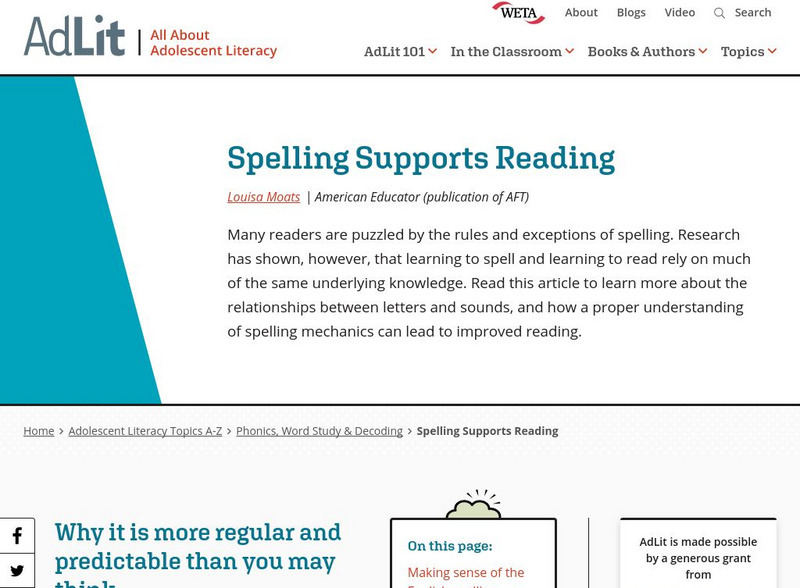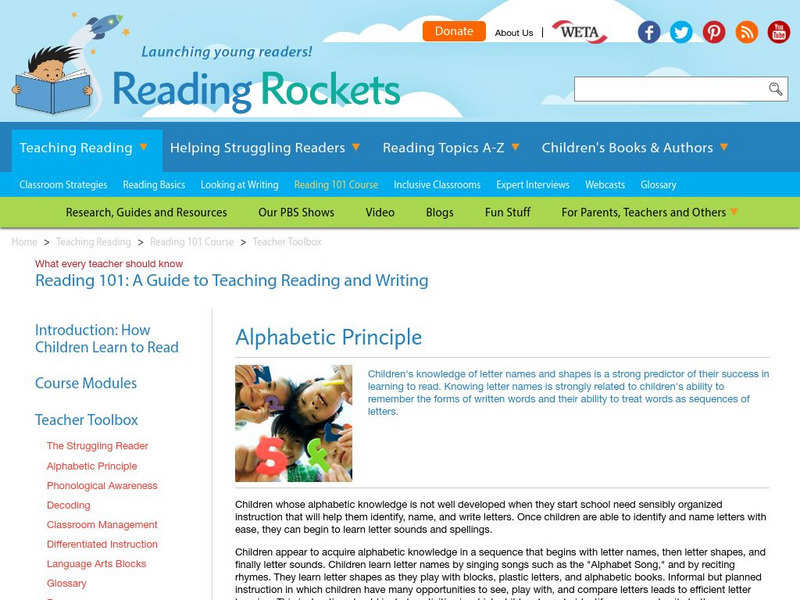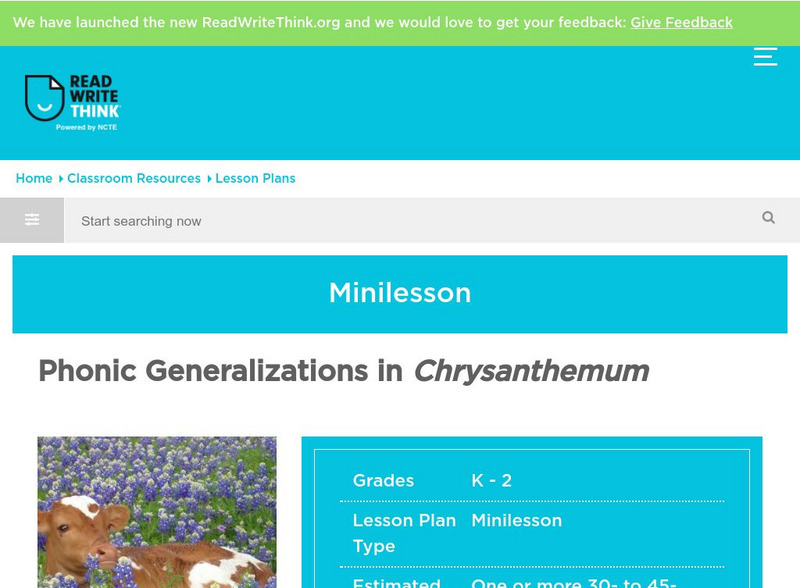St. Charles Place Education Foundation
Reading Bear: 3 & 4 Syllables Lesson
In this beginning reading module, the instructor models how to pronounce words that incorporate three or four syllables in them. Students are prompted to interact with the video segments at various times. Students can choose to sound out...
St. Charles Place Education Foundation
Reading Bear: Ive, Or, Ence Quiz
This site is an interactive quiz to assess knowledge of words with "ive", "or", and "ence" are included on the assessment. The quiz is designed to follow the "Reading Bear: ive, or, ence" lesson.
St. Charles Place Education Foundation
Reading Bear: Ive, Or, Ence Lesson
In this beginning reading module, the instructor models how to pronounce words that incorporate "ive", "or", and "ence" patterns. Students are prompted to interact with the video segments at various times. Students can choose to sound...
St. Charles Place Education Foundation
Reading Bear: Two Syllables Quiz
This site is an interactive quiz to assess knowledge of two-syllable words. The quiz is designed to follow the "Reading Bear: two syllables" lesson.
Reading Rockets
Reading Rockets: Onset/rime Games
Similar to teaching beginning readers about rhyme, teaching children about onset and rime helps them recognize common chunks within words. This can help students decode new words when reading and spell words when writing. This article...
St. Charles Place Education Foundation
Reading Bear: 2 & 3 Syllables Quiz
This site is an interactive quiz to assess knowledge of 2-syllable or 3-syllable words. The quiz is designed to follow the "Reading Bear: 2 & 3 Syllables" lesson.
St. Charles Place Education Foundation
Reading Bear: 3 & 4 Syllables Quiz
This site is an interactive quiz to assess knowledge of 3-syllable and 4-syllable words. The quiz is designed to follow the "Reading Bear: 3 & 4 syllables" lesson.
Other
Sarah Snippets: Syllable Division Rules
Syllable division rules show us how to break up a multi-syllable word into its syllable parts. There are six main syllable division rules to guide us. It all starts with the vowels. Find the vowels in the word. It helps to underline or...
PBS
Pbs Learning Media: Marvin K. Mooney Lesson Plan
In this lesson students get to combine the world of literacy and physical movement! As the teacher reads the book "Marvin K. Mooney Will You Please Go Now" by Dr. Seuss, students listen carefully and safely jump up out of their chairs...
PBS
Pbs Learning Media: Sight Word Spelling Lesson Plan
In this activity students explore with movement and creativity to make words come alive! Using sight word flashcards, students use their bodies to spell out simple sight words.
Auburn University
Auburn University: How Children Learn to Read Words
How do children really learn to read words? This resource offers insight into this complicated but exciting journey of putting sounds and words together to learn the joy of reading. Come and discover more.
AdLit
Ad lit.org: Effects of Intensive Reading Intervention of Decoding Skills
This article summarizes a study that evaluated the effectiveness of intensive instruction in the Word Identification Strategy, a learning strategy for decoding multi-syllabic words. Results indicate that intense strategy instruction...
AdLit
Ad lit.org: Key Literacy Component: Decoding
Decoding is the ability to correctly decipher and identify a word from a string of letters. Students who struggle with decoding are at a disadvantage, but explicit instruction can help them learn this skill.
AdLit
Ad lit.org: Spelling Supports Reading
Many readers are puzzled by the rules and exceptions of spelling. Research has shown, however, that learning to spell and learning to read rely on much of the same underlying knowledge. Read this article to learn more about the...
Reading Rockets
Reading Rockets: Teacher Toolbox Decoding
What are the guidelines for decoding instruction? Explore this website from Readingrockets.org to find out the answer to this question.
Reading Rockets
Reading Rockets: The Alphabetic Principle
What are predictor's for a child's success in reading? Use this site to learn more how the knowledge of the alphabet and shapes is a factor for reading success.
Writing Fix
Writing Fix: Taking the "Un" Out of "Unwritten"
In this lesson plan, young scholars will use a the rap song about prefixes, suffixes and roots and the song "Unwritten" by Natasha Bedingfield. Students will be engaged as they are practice their understanding of prefixes, suffixes and...
Other
Effective Decoding Instruction for Diverse Learners
How can you implement effective decoding instruction for diverse learners in your classroom? This site focuses on phonemic awareness, alphabetic principle, morphology, and the six basic types of syllables in the English language.
Other
Audiblox: Foundational Reading Skills
What types of reading skills do students need to be successful? This informative site focuses on students with learning disabilities. Explore!
Other
Laus Dnet: Grade 1 Word Lesson Plan (Stone Soup) Pdf
In this lesson, students use Stone Soup by Ann McGovern to generate word lists and use patterned text to assist with descriptive writing. Gives links to step sheets and samples for creating a table , a template for shared writing, a...
ReadWriteThink
Read Write Think: Phonic Generalizations in "Chrysanthemum"
This online lesson uses an interactive activity to teach students how to determine the common and alternative sounds for specific vowel combinations. The words for this lesson are taken from the book "Chrysanthemum," by Kevin Henkes....
Other
How to Study: A Word Identification Strategy
Learn eight steps to help you identify unfamiliar words.
Rock ’N Learn
Rock 'N Learn: My Grandpa: Reading Muti Syllable Words
This printable learning exercise from Rock 'N Learn can be used as a reinforcement activity or as an assessment. Students will read sentences that contain multisyllabic words and then identify pictures that contain the multisyllabic...
International Reading Association
Reading Online Articles: Comprehension Instruction
An article on improving reading comprehension through time-tested strategies as well as a summary of new hypotheses about effective comprehension instruction.

